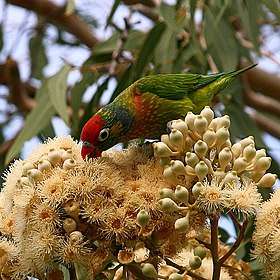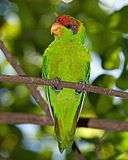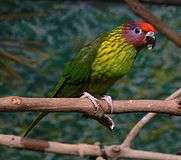Psitteuteles
Psitteuteles is a genus of parrot in the family Psittaculidae.
| Psitteuteles | |
|---|---|
_-upper_body-6-2c.jpg) | |
| Iris lorikeet with a sunflower seed in its beak | |
| Scientific classification | |
| Kingdom: | Animalia |
| Phylum: | Chordata |
| Class: | Aves |
| Order: | Psittaciformes |
| Family: | Psittaculidae |
| Subfamily: | Loriinae |
| Genus: | Psitteuteles Bonaparte, 1854 |
Taxonomy
The genus Psitteuteles was introduced in 1854 by the French ornithologist Charles Lucien Bonaparte.[1] The genus name combines the Modern Latin psitta meaning "parrot" and the Ancient Greek eutelēs meaning "paltry" or "plain".[2] The type species was designated as the varied lorikeet (Psitteuteles versicolor) in 1855 by English zoologist George Robert Gray.[3][4]
The genus contains three species:[5]
- Varied lorikeet (Psitteuteles versicolor)
- Iris lorikeet (Psitteuteles iris)
- Goldie's lorikeet (Psitteuteles goldiei)
Species
| Species | |||
|---|---|---|---|
| Common and binomial names | Image | Description | Range |
| Varied lorikeet (Psitteuteles versicolor) |
 |
19 cm (7.5 in) long. Mainly green with short yellow longitudinal streaks. The lores, forehead, and crown are red. The beak is red, the bare eye-rings are white, the lores are bare, and the irises are orange-yellow. The upper breast is mauve with longitudinal yellow streaks. The legs are bluish-grey. Females are duller and have less the red on the head.[6] | A monomorphic species native to northern Australia[7] |
| Iris lorikeet (Psitteuteles iris) |
 |
20 cm (8 in) long. Mostly green with pale-green transverse striations on its underside. The top of the head is red and there is a purple band from the eyes extending over the ears. The beak is red-orange, the iris is orange, and the legs are bluish-grey. The red on the head of the female is paler and less extensive. The extent and shade of the red and purple on the head varies between two or three subspecies.[6] | Timor and Wetar Island[6][8] |
| Goldie's lorikeet (Psitteuteles goldiei) |
 |
19 cm (7.5 in) long. It is mainly green, and its underside is yellow-green with dark green longitudinal streaks. It has red plumage over the crown, which is less extensive in the female. The back of its head is blue, its cheeks are mainly mauve and blue, its beak is black, and its irises are brown. Its legs are greenish-brown.[6] | A monomorphic species native to the highlands of New Guinea (usually 1000 to 2200 m ASL)[6] of Indonesia and Papua New Guinea[9] |
gollark: That looks kind of optical-drive-y.
gollark: Apparently Zen 2 is using *two* branch prediction things.
gollark: It's still quite cool.
gollark: And they break down the instructions into smaller instructions, and I think somehow execute several of those at the same time on one core.
gollark: And they somehow have billions of transistors switching billions of times a second using less power than an old inefficient lightbulb.
References
- Bonaparte, Charles Lucien (1854). "Tableau des perroquets". Revue et Magasin de Zoologie Pure et Appliquée. 2nd series (in French). 6: 145–158 [157].
- Jobling, James A. (2010). The Helm Dictionary of Scientific Bird Names. London: Christopher Helm. p. 322. ISBN 978-1-4081-2501-4.
- Gray, George Robert (1855). Catalogue of the Genera and Subgenera of Birds Contained in the British Museum. London: British Museum. p. 88.
- Peters, James Lee, ed. (1937). Check-list of Birds of the World. Volume 3. Cambridge, Massachusetts: Harvard University Press. p. 151.
- Gill, Frank; Donsker, David; Rasmussen, Pamela, eds. (2020). "Parrots, cockatoos". IOC World Bird List Version 10.1. International Ornithologists' Union. Retrieved 24 February 2020.
- Forshaw (2006). plate 14.
- BirdLife International (2008). "Psitteuteles versicolor". IUCN Red List of Threatened Species. 2008. Retrieved 2 October 2009.CS1 maint: uses authors parameter (link) CS1 maint: ref=harv (link)
- BirdLife International (2008). "Psitteuteles iris". IUCN Red List of Threatened Species. 2008. Retrieved 2 October 2009.CS1 maint: uses authors parameter (link) CS1 maint: ref=harv (link)
- BirdLife International (2008). "Glossopsitta concinna". IUCN Red List of Threatened Species. 2008. Retrieved 2 October 2009.CS1 maint: uses authors parameter (link) CS1 maint: ref=harv (link)
Cited texts
- Forshaw, Joseph M. (2006). Parrots of the World; an Identification Guide. Illustrated by Frank Knight. Princeton University Press. ISBN 0-691-09251-6.
This article is issued from Wikipedia. The text is licensed under Creative Commons - Attribution - Sharealike. Additional terms may apply for the media files.